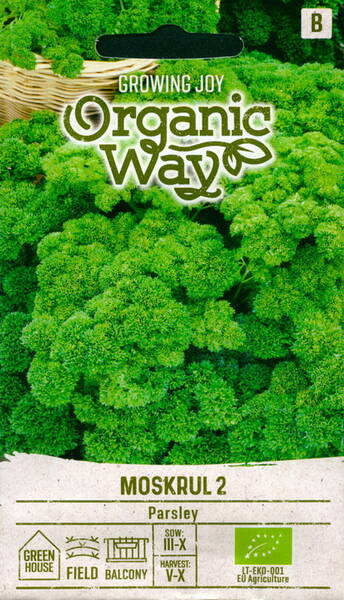Ex Tax: 0.95€
Very aromatic taste.
Mid-season variety. The leaves are curly, dark green with medium-long petioles. A variety of leaf parsley with highly corrugated, very beautiful leaves and a pleasant aroma. Plants are relatively compact, drought tolerant. The roots overwinter well, in early spring they give greens rich in vitamins. Keeps fresh for a long time after cutting.
It is sown in open ground from April to July, in room conditions it can grow all year round.
1,0 g = 450-650 seeds.
Parsley is a spicy and flavorful vegetable culture. Possesses high cold resistance and early maturity. Demanding on soil fertility, light, soil moisture and air. Before sowing, it is advisable to soak the seeds in water for 1-2 days.
To get early greenery, you can sow dry seeds before winter. Sowing depth 0.5-1 cm, distance between lines 15-20 cm.
Seeding rate: 0.5-0.6 g / m2. Seedlings appear only after 3 weeks. During the period of seed germination, the soil should not be allowed to dry out, otherwise germination will significantly decrease.
After the emergence of seedlings, the rows are thinned, leaving 2-5 cm between the plants. When harvesting leafy varieties, the leaves are cut off throughout the summer with a break of at least 30-40 days.
* Parsley in ancient Greece enjoyed the same respect as in religious India. She was considered a sacred plant symbolizing glory and joy. Indeed, in solemn moments, she served as an adornment for Hercules.
As a spice, this culture began to be used in the Middle Ages thanks to Charlemagne, who ordered to grow it in his gardens. Soon, parsley became an indispensable addition to all vegetable dishes.
The value of parsley is associated with the high content of carotene and vitamin C, the presence of other vitamins (B1, B2, B6, PP), as well as potassium, sodium, magnesium, calcium, phosphorus, iron. In terms of the amount of potassium, it ranks first among vegetables, and in the presence of vitamins it is not inferior to oranges.
Parsley is highly regarded in medicine for its medicinal properties. Seeds, roots, leaves and stems are used as medicinal raw materials.
The plant has a diuretic, choleretic, antispasmodic, detoxifying and antiseptic effect.
Parsley is used as a diuretic for renal and cardiovascular diseases accompanied by edema.
Infusion and decoction of seeds and leaves are used for kidney stones, inflammation of the mucous membrane of the urinary tract. The use of a decoction is effective for decompensated heart defects.
Outwardly, a decoction of parsley is indicated for abscesses, bruises, bites, mosquitoes, bees and wasps.
Eng.: Leaf Parsley (tops). Bot: Petroselinum crispum convar. vulgare.
* How long does it take for parsley seeds to germinate?
Parsley seeds contain a large amount of essential oils that prevent germination, so they take a long time to germinate. Essential oils can be washed off by holding the seeds in a gauze bag under a stream of hot (+60+65°C) water for half an hour, drying them a little on paper until they become loose, and sowing them immediately.
Parsley takes a long time to germinate, from 10 to 15 days, so the beds should be free of weeds that can drown out cultivated crops.












